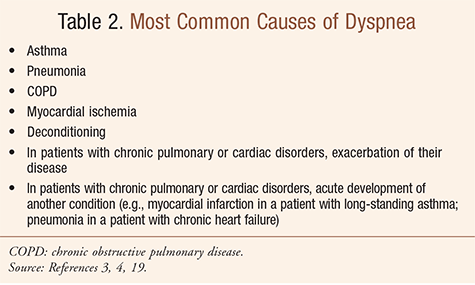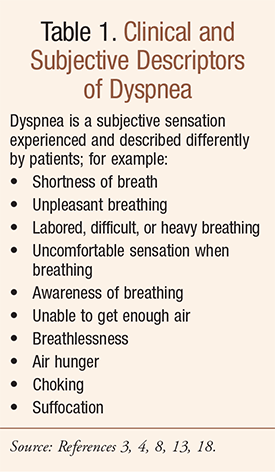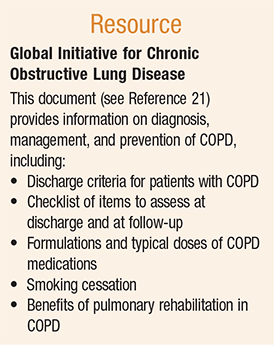Clinically, dyspnea is defined as
labored or difficult breathing. However, dyspnea is a subjective
experience of breathlessness, and patients describe it as they
experience it (TABLE 1), with variations depending on its cause.
Owing to its subjective nature, as with pain, dyspnea is an experience
influenced by both physiological and psychological factors.1
It is important to note that the intensity of the dyspnea reported
subjectively does not correlate with pulmonary function tested via
objective measures.2 For example, dyspnea can be experienced
despite normal pulse oximetry and respiratory rate. It is likely that
the experience of dyspnea results from a complex interaction between
chemoreceptor stimulation, mechanical abnormalities in breathing, and
the perception of those abnormalities by the central nervous system
(CNS).3
Referred to as neuromechanical uncoupling
by some authors, dyspnea is described as an imbalance between
neurologic stimulation and mechanical changes in the lungs and chest
wall.3
Dyspnea is not only a symptom of severe or chronic pulmonary disease, but is also associated with a wide variety of pulmonary, cardiac, and other causes. Many of these conditions are common among the elderly, such as heart failure, cancer, and dementia, as well as neurologic disorders such as cerebrovascular accidents, amyotrophic lateral sclerosis (ALS), and AIDS.1 More than 56% of patients with advanced chronic obstructive pulmonary disease (COPD) and 70% of individuals with advanced cancer report moderate-to-severe dyspnea.4 Overall, dyspnea is one of the most common and distressing symptoms experienced by seriously ill older adults.
Dyspnea-associated conditions vary by
acuteness of onset. Acute dyspnea occurs within minutes of the
triggering event (e.g., asthma, pulmonary embolism, myocardial ischemia
or infarction); subacute dyspnea occurs within hours to days, as in
angina, pneumonia, and COPD exacerbation; and chronic dyspnea occurs
within hours to years—examples include pleural effusion, heart failure,
anemia, and physical deconditioning.3 The most common cause of dyspnea in patients with chronic pulmonary or cardiac disorders is exacerbation of their disease (
TABLE 2
).3 Dyspnea is also one of the most common symptoms reported by patients receiving palliative care.1
Dyspnea can be extremely distressing not only for the patient, but for
many families and caregivers alike who witness an episode.5
An appropriate and well-placed intervention, such as pulmonary
rehabilitation (see below), has the potential to improve overall quality
of life and reduce hospitalizations and readmissions.

Dyspnea on Exertion
Angina pectoris is a clinical syndrome of coronary artery disease that is caused by myocardial ischemia and characterized by dyspnea and precordial discomfort, pressure, or pain.6 This syndrome is typically precipitated by exertion and relieved by rest or sublingual nitroglycerin. The etiology of angina-associated dyspnea on exertion is a transient increase in left ventricular end-diastolic pressure secondary to ischemia, superimposed on reduced ventricular compliance.6 Pharmacists should note that, in the elderly, dyspnea on exertion is a more common manifestation of myocardial ischemia than is chest pain.6 Physical deconditioning can cause dyspnea only on exertion in patients with a sedentary lifestyle, while anemia can cause dyspnea on exertion progressing to dyspnea at rest.3
Paroxysmal Nocturnal Dyspnea
Paroxysmal nocturnal dyspnea (PND) is defined as respiratory distress that awakens patients from sleep; it is related to posture (especially reclining at night) and is attributed to congestive heart failure (CHF) with pulmonary edema, or in some cases to chronic pulmonary disease.7 Patients with CHF and pulmonary vascular congestion may complain of dyspnea with exertion or even at rest, orthopnea (dyspnea that is relieved in the upright position), PND, and nocturia.8 PND is a major criterion for the diagnosis of CHF.9 Clinically, patients with hypothyroid cardiomyopathy, a condition that can lead to heart failure, are somewhat unusual in that they are likely to experience dyspnea without orthopnea.9
Dyspnea as a Symptom of COPD
Asthma and COPD are common disorders associated with significant morbidity and mortality in the elderly.10 COPD, diagnosed in the sixth decade in most patients, continues to be underrecognized despite its status as an important chronic disease and a leading cause of disability in seniors.11 Whether dyspnea is caused by COPD or asthma, a number of studies have shown that symptoms of obstructive lung disease are underreported by the elderly and either underdiagnosed or misdiagnosed by physicians.12
Dyspnea is the most common and disabling symptom of COPD, usually beginning after age 50 years and following a path of progressive worsening.6 Dyspnea often produces a vicious circle of inactivity, anxiety, and depression6:
• Inactivity leads to deconditioning and a reduction in muscle strength and cardiac function that exacerbates activity-induced dyspnea
• Anxiety is provoked when the patient anticipates that an activity will result in dyspnea (anticipatory dyspnea)
• Anxiety then leads to an increased heart and respiratory rate, resulting in increased dyspnea
• Risk of depression increases secondary to anxiety and activity limitations.
Intervention with pulmonary rehabilitation (see below) aims to interfere with the vicious circle of dyspnea by decreasing each symptom in the circle.6
Assessment of Dyspnea: Validated Tools
The cause, findings, and diagnostic approach for each category of dyspnea (acute, subacute, chronic) can be reviewed online (see Reference 3).3 Given the subjectivity of this distressing symptom, its assessment and management can be challenging.1 The subjective intensity of dyspnea may not correlate with pulmonary dysfunction evaluated by objective tests including pulse oximetry, chest X-rays, or pulmonary function tests.2
Validated instruments for assessing
dyspnea severity include the Visual Analog Scale (VAS) and the modified
Borg Scale, which have been used in palliative care.1,13-15
Breathlessness measurement using the Modified British Medical Research
Council (mMRC) Questionnaire relates well to other measures of health
status and predicts future mortality risk of patients with COPD; it may
be helpful in selecting patients most likely to benefit from pulmonary
rehabilitation.21
Palliative Management in Seriously Ill Seniors
Treatment of dyspnea in seriously ill older adults is initiated by treating the underlying etiology whenever possible (i.e., for COPD, using corticosteroids, inhaled beta2 agonists, and anticholinergics; for advanced heart failure, using diuretics, beta-blockers, and ACE inhibitors).4,16,17 Of note, antibiotics have a role in symptom management, even in the terminally ill, for resolution of pleuritic pain and the sensation of systemic illness associated with pneumonia and infection.18 When these therapies are not effective, symptomatic treatment recommendations include the following4,16,19:
Oxygen provides relief of dyspnea for breathlessness in the presence of hypoxia; oxygen provides symptomatic relief even when hypoxia is not present; the use of fans or positioning of patients near an open window or door can be effective in relieving breathlessness (via direct stimulation of the V2 branch of the trigeminal nerve in the nares).
Opioids (e.g., morphine) are considered the gold standard treatment for dyspnea; patients in randomized, controlled trials demonstrate significantly reduced breathlessness without measurable reductions in respiratory rate or oxygen saturation. This effect occurs via several mechanisms: Opioids 1) diminish ventilatory response to hypoxia and hypercapnea; 2) act centrally to decrease the subjective sensation of breathlessness; and 3) reduce preload—they are effective for patients with symptoms of volume overload associated with advanced renal or heart disease. Furthermore, effective doses are lower than those used to treat pain; tolerance has not been demonstrated to be a clinical problem.
Anxiolytics are useful in decreasing suffering and interrupting the circle of anxiety-dyspnea-anxiety, as described above, in patients with severe dyspnea. Benzodiazepines may decrease anxiety and reduce breathlessness; since lorazepam has a relatively short half-life and has no active metabolite, it is a preferred agent for use in the elderly.
In addition to the above, the following palliative management measures should also be considered:
Pulmonary rehabilitation is a comprehensive program that incorporates the principles of relaxation, breathing control, activity pacing, and efficient mobilization; clinical improvement is manifested by reduced dyspnea, increased exercise tolerance, improved quality of life, and decreased hospitalizations.6,20 Pulmonary rehabilitation has been carefully evaluated in a large number of clinical trials; benefits have been reported from rehabilitation conducted in inpatient, outpatient and home settings.21
Other modalities that may decrease anxiety and diminish feelings of breathlessness include relaxation, massage therapy, distraction, and reassurance.4,19
Nutritional consultation is important, especially in the elderly, who may be missing many essential components of a healthy diet. Respiratory muscle strength may be improved by improving patients’ nutritional status.22
Caregiver Support
Patients require stamina and a positive attitude to perform activities of daily living, and the role of the caregiver—as well as the burden of caregiving—should not be underestimated. In addition, caregivers need to be aware of and respect the wishes of the patient, including issues with regard to advance directives.23 Rather than reacting to crises, healthcare providers should be actively involved in anticipating and preparing family and caregivers for these circumstances. Through educating families and caregivers about potential medication side effects, complications, or emergencies, pharmacists can become involved with providing concrete interventions that caregivers might implement to manage these situations.1
Pharmacist’s Role: Multifaceted
Pharmacotherapy plans should include
ongoing assessment and evaluation of medication therapy, open dialogue
and communication with interdisciplinary healthcare team members,
guidance for medication adherence, appropriate referral for palliative
care services, and family and caregiver education that addresses the
need for appropriate and palliative treatment for patients experiencing
dyspnea. Preventing and reducing hospitalizations and readmissions for
patients who are experiencing dyspnea, or who have a history of dyspnea,
through proper treatment and management is a pragmatic and
compassionate healthcare goal.
REFERENCES
1. Indelicato RA. The advanced practice nurse’s role in palliative care and the management of dyspnea. Topics in Advanced Practice Nursing eJournal. 2006;6(4). www.medscape.com/viewarticle/551364_4. Accessed June 18, 2014.
2. Ries AL. Impact of chronic obstructive pulmonary disease on quality of life: the role of dyspnea. Am J Med. 2006;119:S12-S20.
3. Dyspnea. MerckManuals.com. Last full
review/revision July 2012; last modified November 2013.
www.merckmanuals.com/professional/pulmonary_disorders/symptoms_of_pulmonary_disorders/dyspnea.html.
Accessed June 18, 2014.
4. Chun A, Morrison RS. Palliative care. In: Halter JB, Ouslander JG, Tinetti ME, et al, eds. Hazzard’s Geriatric Medicine and Gerontology. 6th ed. New York, NY: McGraw-Hill; 2009:373-383.
5. Del Fabbro E, Dalal S, Bruera E. Symptom control in palliative care—part III: dyspnea and delirium. J Palliat Med. 2006;9:422-436.
6. Beers MH, Berkow R, eds. The Merck Manual of Geriatrics. 3rd ed. Whitehouse Station, NJ: Merck & Co; 2000:779-787, 806-809.
7. Dorland’s Pocket Medical Dictionary. 28th ed. Philadelphia, PA: Saunders Elsevier; 2009.
8. Lange RA, Hillis LD. Cardiovascular testing. In: DiPiro JT, Talbert RL, Yee GC, et al, eds. Pharmacotherapy: A Pathophysiologic Approach. 8th ed. New York, NY: McGraw-Hill Inc; 2011:55-81.
9. Braughman KL, Weisfeldt ML. Congestive heart failure. In: Barondess JA, Carpenter CC, eds. Differential Diagnosis. Philadelphia, PA: Lea & Febiger; 1994:91-116.
10. Zagaria ME. Differential diagnosis of asthma and COPD in older adults: role of spirometry. US Pharm. 2011;36(7):20-24.
11. Yende S, Newman AB, Sin D. Chronic obstructive pulmonary disease. In: Halter JB, Ouslander JG, Tinetti ME, et al, eds. Hazzard’s Geriatric Medicine and Gerontology. 6th ed. New York, NY: McGraw-Hill; 2009:987-1001.
12. Braman SS, Abu-Hijleh M. Asthma and chronic obstructive pulmonary disease. In: Brocklehurst’s Textbook of Geriatric Medicine and Gerontology. Philadelphia, PA: Saunders Elsevier; 2010:362-375.
13. Thomas JR, von Gunten CF. Management of dyspnea. J Support Oncol. 2003;1:23-32; discussion 32-34.
14. Borg G. Psychophysical bases of perceived exertion. Med Sci Sports Exerc. 1982;14:377-381.
15. Ghofrani HA, Galiè N, Grimminger F, et al. Riociguat for the treatment of pulmonary arterial hypertension. N Engl J Med. 2013;369:330-340.
16. Semla TP, Beizer JL, Higbee MD. Geriatric Dosage Handbook. 19th ed. Hudson, OH: Lexicomp; 2014:35-37, 721-722, 806-808, 810-811, 880-883.
17. Clark MA, Finkel R, Rey JA, eds. Pharmacology. 5th ed. Baltimore, MD: Lippincott Williams & Wilkins; 2012:193-206, 339-350.
18. Finlay I, Capel M. Palliative medicine for the elderly patient.
In: Fillit HM, Rockwood K, Woodhouse K, eds. Brocklehurst’s Textbook of Geriatric Medicine and Gerontology. 7th ed. Philadelphia, PA: Saunders Elsevier; 2010:973-982.
19. Morrison RS, Meier DE. Palliative care. N Engl J Med. 2004;350:2582-2590.
20. Ripamonti C, Bruera E. Dyspnoea: pathophysiology and assessment. J Pain Symptom Manage. 1997;13:220-232.
21. Global Initiative for Chronic Obstructive Lung
Disease. Global Strategy for the Diagnosis, Management, and Prevention
of Chronic Obstructive Pulmonary Disease. Updated 2013.
www.goldcopd.org/uploads/users/files/GOLD_Report_2013_Feb20.pdf.
Accessed June 26, 2014.
22. Tauer KM, Farr GE. Lower respiratory disorders. In: Youngkin EQ, Sawin KJ, Kissinger JF, et al. Pharmacotherapeutics: A Primary Care Guide. Upper Saddle River, NJ: Pearson Prentice Hall; 2005:367-407.
23. Zagaria ME. Advance directives for medical decisions. US Pharm. 2012;37(7):20-22.
To comment on this article, contact rdavidson@uspharmacis.com.







